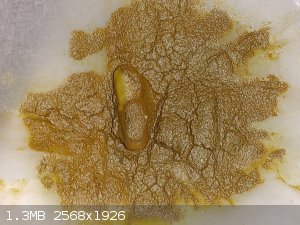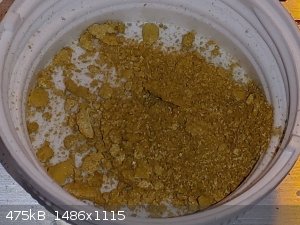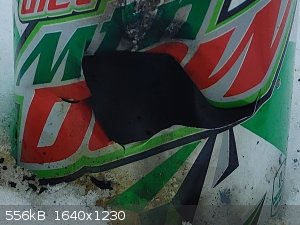
night429 - 28-12-2022 at 01:12
I made a mention of this compound last year in the exotic primaries thread, but figured that I may as well make a post of a more thorough analysis of
this compound.
My steps towards synthesizing this compound were as follows:
I weighed out 500mg of tetraamminecopper(ii) sulfate and added it to about 5mL of lukewarm water, then swirled to dissolve.
I then shot in about 0.5mL of ~10% ammonia solution with a pipette and swirled again to mix.
In a separate beaker, I added 500mg of ammonium picrate crystals to about 25mL of warm water. I used magnetic stirring and a small amount of
heat to dissolve everything.
I then added the tetraamminecopper(ii) sulfate solution to the stirring ammonium picrate solution. Immediately, a gold precipitate formed.
I let it stir for a minute more, then filtered off the precipitate using a coffee filter. The filtrate remained a deep blue due to the
significant excess of tetramminecopper(ii) sulfate used.
I washed the product and filter with a small amount of cold water, then dried—first using a paper towel to remove free water, then a fan to
completely dry it.
After it was dry, it weighed 572mg, which is a yield of 94.3% (theo. 597mg).
Wet product (left) and dry product (right):


The only compound I can think of this to be is tetramminecopper(ii) picrate, as the ammonium concentration was too high to allow for copper(ii)
picrate to form, and even the filtrate remained the characteristic tetramminecopper(ii) color. As well as that, the color of the product is markedly
different than copper(ii) picrate, which is a lime green and not a gold. Exposure to flames gives results of both a copper compound (green-ish tint to
the flame) and a picrate (rapid, sooty decomposition). As a result, I'm fairly confident that the compound I've isolated is, in fact,
tetramminecopper(ii) picrate.
The performance of the compound is nothing extraordinary. Exposure to flame first causes melting to a black liquid, then slight bubbling occurs. This
is followed by rapid decomposition with a sooty orange flame and an audible hissing noise; heating while tightly confined in aluminum foil does not
allow DDT to occur. A shock test did not cause a small amount of compound to detonate, nor did a friction test, although it's possible that my testing
was inadequate for both.
An attempt to induce detonation of 100mg of the compound with 10mg of silver nitrotetrazoleate resulted in most, if not all, of the compound failing
to detonate. This was done using an aluminum can as a baseplate and both a paper straw (pictured below) and a .22LR shell casing, with very similar
results for both. Damage was slightly more than just 10mg of silver nitrotetrazoleate, but this could be because I performed this test on a different
side of the aluminum can.

I may do some more testing in the future to see if I can, in fact get it to detonate. But, I'm unable to do it at the present moment.
Laboratory of Liptakov - 28-12-2022 at 04:27
Perfectly description of preparation and properties. Including a critical view of the researched material. We thanks. Well, every unsuccess is next
step to successful. Is necessary always do detail notes. Against repeating a same attempt or same error. Sometimes I go back to my books. So that I
don't repeat the same (unsuccessful) attempt. A solid metal cavity can be (and often is) cruical to discovering the DDT properties of a test
substance.
Hey Buddy - 28-12-2022 at 07:45
Picrate is interesting. It's clear that additional simply manufactured primaries are the greatest need in this field. DDNP and aminoguanidine
perchlorate salts are 80% of the way there, lead azide and SADS, just behind that, of course NPED pyrotechnic mixes, but the need will continue to
exist until there are many routes to primaries with less processing. After that is done, it will open up widespread testing of more secondaries.
Efforts like this help towards that reality. Thank you.
Fantasma4500 - 10-1-2023 at 16:32
luckily for the environment, dichromate or chromate doesnt seem to form copper complexes
nitronate perhaps?
critical diameter may be cause for failure, very impressive yield especially in such quantities considering mechanical losses
